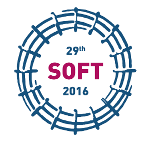Speaker
Alessandro Lampasi
(Department of Fusion and Technology for Nuclear Safety and Security)
Description
The power supplies (PSs) of the DTT proposal, as presented in the talk "Design and definition of a Divertor Tokamak Test facility" invited at this conference, have to feed:
6 central solenoid (CS) and 6 poloidal field (PF) superconducting coils, with currents up to 25 kA.
18 toroidal field (TF) superconducting coils, with a current up to 50 kA.
Some fast plasma control coils, including at least 2 internal coils for vertical stabilization.
The electron (ECRH) and ion (ICRH) cyclotron additional heating systems, for about 25 MW delivered to the plasma.
All auxiliary systems and services for more than 100 MVA.
An upgrade of the heating system, able to deliver to the plasma further 20 MW, especially by a neutral beam injector (NBI).
The CS and PF PS circuits include a 4-quadrant 12-pulse AC/DC converter in series to a quench protection circuit (QPC) and, in most cases, a switching network unit (SNU). The voltages and currents to be provided by the converters were estimated applying the reference scenarios to a model of the PF circuits, taking into account the mutual couplings and the SNU contributions.
The independent evaluation of the electrical requirements of each PS system led to the definition of the active, reactive and apparent power scenarios. Due to the pulsed PSs (serving CS, PF, ECRH, ICRH, NBI), the 100-MVA continuous load can reach 350 MVA with a duty cycle of 100s/3600s. The feasibility of these scenarios at the ENEA Center in Frascati was verified, including a compensation of the power factor up to 0.9, also with the support of the Italian transmission grid operator. The solution identified to supply all the facility directly from the national grid requires a new 150 kV line specifically for DTT and a new substation with two 150kV/36kV transformers inside the ENEA Center.
Co-authors
Alessandro Lampasi
(Department of Fusion and Technology for Nuclear Safety and Security, ENEA, Frascati, Italy)
Elena Gaio
(Consorzio RFX, Padova, Italy)
Fabio Starace
(Department of Fusion and Technology for Nuclear Safety and Security, ENEA, Frascati, Italy)
Giuseppe Maffia
(Department of Fusion and Technology for Nuclear Safety and Security, ENEA, Frascati, Italy)
Loris Zanotto
(Consorzio RFX, Padova, Italy)
Maria Carmen Falvo
(University of Rome Sapienza, Rome, Italy)
Pietro Costa
(Department of Fusion and Technology for Nuclear Safety and Security, ENEA, Frascati, Italy)
Pietro Zito
(Department of Fusion and Technology for Nuclear Safety and Security, ENEA, Frascati, Italy)
Sergio Ciattaglia
(EUROfusion Consortium, Garching, Germany)
Simone Minucci
(University of Naples Federico II, Naples, Italy)
Vanni Toigo
(Consorzio RFX, Padova, Italy)

